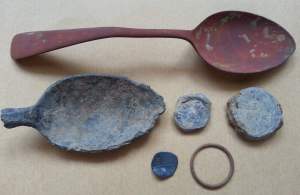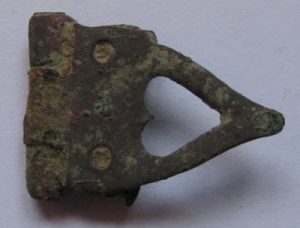A 600-year-old gold ring engraved with St George and the Dragon sheds new light on the saint’s medieval followers in Norwich, an expert has told the BBC.
The ring, found by a metal detectorist in South Creake, Norfolk, dates from between 1350 and 1430.
Dr Jonathan Good, author of The Cult of St George, said the ring “attests to the popularity of St George” and may be linked to a guild devoted to the saint.
The ring was ruled to be treasure at an inquest in Norwich this week.
It is set to be acquired by Norwich Castle Museum.
Tag Archives for medieval
More spoons, lead seals and a hammy
It was such a lovely afternoon it would have been criminal to let it go to waste. So out I went, back to Permission 1 – the barren one which makes me sweat blood for every half decent find. I had hoped to return to the field which produced two fruitful afternoons last month, but the rhea are still in it and apparently they are even randier now than they were then. I didn’t fancy my chances. As a result I decided to try a field I’ve not detected before.
From the start it looked as though it was going to be a crap afternoon. Not only did I forget my flask of coffee, but Tect O Trak, the app I’m currently using on the phone for tracking my movements round fields and logging finds, decided not to work again.
By far the best find of the day was a tiny hammy (12mm x 10mm and 0.32g and therefore probably a farthing), the first I have found on this permission, which came from just off a public footpath running through the farm and was about 10″ down. Well done the Deus. Presumably this is evidence of a sort that the footpath was probably being used in the medieval period if not earlier, so systematically detecting the path on a future visit seems like a good move. Unfortunately the coin is poorly struck and off centre so whether it will be possible to identify the mint and moneyer remains to be seen. I will try to upload larger and clearer images of both sides of the coin as soon as possible in the hope that someone can fully identify it.
And another pewter spoon, or rather part of one. They seem to be surprisingly common on this farm for some reason. I’m starting to think of it as Death of Spoons Farm.
And two lead seals – one from a case of Moët & Chandon champagne and the other probably from a fertiliser sack, though I can’t make out the name of the company concerned.
Finds
1 hammy
1 pewter spoon (part)
1 nickel-plated spoon
1 bag seal
1 Moet & Chandon champagne case seal
1 small ring
Finnish detectorists find thousand-year old swordsman
Archaeology hobbyists were stunned when they unearthed a remarkable historical find from a field in Janakkala, southern Finland. The ancient grave site appeared to be that of an early crusader buried with two swords from different eras.
The well-preserved grave contained an uncharacteristically large 12th-century sword as well as what appeared to be a Viking-age blade that may have been part of a cremation ceremony.
The amateur historians were using a metal detector in a field in Hyvikkala, Janakkala, which had showed signs of pre-historic settlement. After uncovering a few minor objects, the metal detector picked up a spear tip and an axe blade. After some digging, the group discovered a broken sword. At this point, the hobbyists broke off their work to alert the National Board of Antiquities (NBA).
Aurelia and the Beanstalk
I attended another club dig yesterday, this time in the Bedford area, on 4 fields of bean stubble. The soil was heavy clay and it had been raining heavily overnight and continued to rain almost all day. I lasted 2 hours before giving up, looking like something risen from a primaeval swamp to terrify small children. I shivered all the way home and had a stiff drink and a hot shower when I got there.
The mud was Biblical. My pin pointer was covered to half a inch thick. Eventually I couldn’t find the on/off switch and the little speaker vents were covered with mud so I couldn’t actually hear it bleep. My finds pouch was filled with mud, the pin pointer holster was filled with mud, my knee pads stuck to the ground every time I knelt down, and both the spade handle and the detector stuck to my hand. It wasn’t just the mud, but all the loose bits of vegetation that stuck to the mud. If I wasn’t a primeval swamp monster I was at least a walking compost heap. So I gave up.
The fields were generally quiet as regards actual signals. The odd iron grunt, the occasional good signal and an awful lot of chirps and chatter. The latter was because the coil reacted every time it struck a bean stalk. Unlike wheat or barley stubble, which the coil just pushes out of the way, bean stubble is much thicker and stronger which added to the problems of the mud.
In two hours I dug 4 pieces of God-knows-what. It was impossible to work out in the field what they were because of – did I mention the mud? The more I tried to rub it off on the spot the more I seemed to rub on. Eventually I put the nondescript pieces of metal in my finds pouch, hoping they would not stick to the trowel and be lost again.
It took me several hours this morning to clean the mud off most of my equipment and to have a look at my finds. Three pieces of scrap lead and 1 copper alloy book clasp or strap end which will be going to see the FLO in December.
Those who stuck it out were rewarded for their persistence. Other finds included a dozen or more hammered coins, a Bronze Age gold ring and a medieval bronze figure of Christ some 4″ to 5″ tall, presumably from a large crucifix. There are going to be some very happy FLOs I suspect.
Finds: 1 strap end (probably).
Huntingdon finds declared treasure
Two museums are set to benefit from ancient treasure unearthed by metal detector users at sites near Huntingdon.
The Museum of Archaeology and Anthropology in Cambridge wants to acquire a hoard of 140 rare Roman coins dating back to the third century and the Norris Museum in St Ives, has expressed an interest in a medieval silver-gilt ring.
Assistant coroner Belinda Cheney declared both finds to be treasure at an inquest in Huntingdon.
The finds were made by metal detector users hunting on farmland in Huntingdonshire with the landowner’s permission.
Club Dig – Daventry
Sometime back in the spring I indicated interest in joining a particular metal detecting club, and having received no response to my initial enquiry I shrugged my shoulders and forgot about it completely. Then a fortnight ago I received an invitation to join it and, after a telephone conversation with the organiser, coughed up my joining fee. And yesterday I attended my first club dig with 49 other detectorists on around 100 acres of stubble somewhere in Northamptonshire. Actually in the general area of Daventry but that’s the closest geographic information you’re going to get.
Unfortunately when we arrived the farmer had covered the lot with chicken shit poultry manure. Even more unfortunately the locals complained about the stink so he ploughed the lot and ploughed it deep enough to involve ridges and furrows, around 18″ from crest to crest and some 9″ or thereabouts from trough to crest. Not good, especially as both troughs and crests were liberally scattered with great clods which made swinging the detector decidedly problematic. The state of the fields was very like that faced several weeks earlier at the NCMD Shakespeare Hospice Rally, though the soil in this case was more loamy than the solid clay of the Stratford area. It was therefore softer underfoot, less likely to break ankles, and quite a lot easier to dig.
During the course of the morning, the farmer took a tractor and disking unit around the outside edges of the fields to mitigate the worst of the troughs and furrows, but by late morning a nearby pasture field had been opened up for those who were struggling on the ploughed land.
After a couple hours on the ploughed fields, during which I found one (count ’em) musket ball, and after a coffee and a Twix, I repaired to the pasture field where I dug a fair amount of rubbish, including a large horse shoe, a handful of shotties and an air filter unit from a vehicle of some sort, and my only other actual find of the day – a halfpenny. There was the usual evidence of selfish behaviour on the pasture field: I swung my detector over at least 3 holes which gave off very loud signals, and there were at least half a dozen others where the turf had been put back only approximately and a substantial soil scatter left around the hole. I wonder if clubs ever really manage to stamp out this sort of behaviour.
Overall, finds were understandably rather sparse. The site had been visited previously with good results, but by the time I left at around 2.30pm the best finds that day included a mediaeval book clasp, a siliqua, a half-groat and a handful of other similarly pleasing but not spectacular finds.
But one good thing – the club has an absolute rule that headphones must be worn while detecting, so that although there were a number of Garrett Ace machines on the fields the rest of us were spared the incessant distant and not-so-distant ding-donging of the Yellow Perils.
Looking back, I wish I’d hung around longer and chatted to more people. At the time I left dark, thunderous-looking clouds had been building for an hour or more and it looked as though a downpour was in the offing but as I was driving back to the motorway the sky cleared and everything was bathed in late afternoon sunlight. Unless we get an Indian summer, that may have been the last hooray of this year’s fine weather.
Finds: 1 musket ball and 1 1958 halfpenny.
13th century gold ring found in Sleaford
A metal detecting enthusiast has dug up the find of a lifetime by unearthing a 13th century gold ring worth thousands of pounds.
John Cooper, formerly of Sleaford but now living in Cheshire, has been following his hobby of metal detecting in the Sleaford area for the last 30 years, in the past finding such things as Roman coins and brooches.



